JOAO BATISTA JR
local onde publico os textos & artigos maiores citados no BLOG0NEWS de modo que os posts de lá não fiquem enormes.
JOAO BATISTA JR
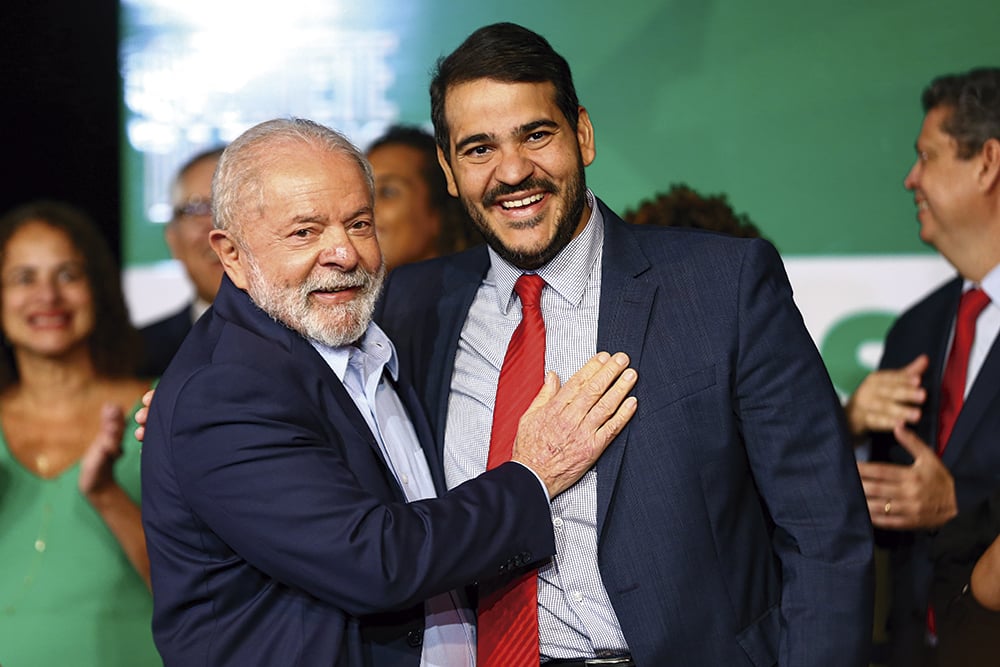
Com a provável indicação do chefe da AGU para o Supremo, o presidente aposta em uma reaproximação com os evangélicos
Por Maurício Thuswohl
A “Parábola do Semeador”, narrada nos evangelhos de Mateus, Marcos e Lucas, conta a história de um lavrador que espalhou sementes em diferentes tipos de solo. Algumas ficaram pelo caminho e foram devoradas por aves. Outras caíram em terreno pedregoso e até germinaram, mas logo secaram por falta de raízes. Houve também as sufocadas por espinhos. Só as que encontraram terra fértil vingaram e deram frutos. Assim é a palavra do Senhor: só frutifica quando acolhida por corações dispostos a ouvi-la.
É com base nessa sabedoria que Lula tenta construir um novo canal de diálogo com o eleitorado evangélico, um dos segmentos mais refratários ao seu governo. Entre os fiéis, a taxa de desaprovação (61%) ainda supera, com folga, a de aprovação (35%), segundo levantamento do Instituto Quaest divulgado em setembro. O presidente sabe: reverter, ainda que parcialmente, esse cenário pode ser decisivo na disputa pela reeleição no ano que vem.
Alguns gestos na direção dos evangélicos vêm sendo feitos pelo governo, pelo PT e pela esquerda em geral desde o início do terceiro mandato de Lula. O mais importante deles deve ser a escolha de Jorge Messias, advogado-geral da União e fiel da Igreja Batista Cristã de Brasília, para a vaga aberta no Supremo Tribunal Federal com a aposentadoria precoce de Luís Roberto Barroso. O anúncio só deve ocorrer na próxima semana, após o retorno do presidente de visitas oficiais à Indonésia e Malásia. Lula já está com “convicção formada”, afirmou à CNN Brasil o líder do governo no Senado, Jaques Wagner (PT). “Entendo que ele ainda não tenha oficializado porque faltam algumas conversas para azeitar as indicações.”
Entre os fiéis, a desaprovação ao governo (61%) é bem superior à aprovação (35%)
Nordestino, jovem, leal ao governo, com sólida formação jurídica, presença forte nas redes sociais e integrante de uma igreja cristã tradicional, Jorge Messias reúne diversos predicados para ocupar uma cadeira no STF – apesar dos apelos de movimentos sociais por maior representatividade racial e de gênero em um tribunal que, em 134 anos, teve apenas três mulheres e nenhuma ministra negra. Sua indicação é vista, porém, como estratégica para reconquistar terreno num setor que se tornou majoritariamente hostil ao petismo. Lula perdeu para Bolsonaro em 11 dos 14 estados com maior proporção de evangélicos, segundo o Censo do IBGE.
O presidente aposta na capacidade de Jorge Messias dialogar não apenas com evangélicos tradicionais, mas também de se aproximar do segmento neopentecostal, majoritariamente ligado ao bolsonarismo. Dois episódios recentes ilustram esse potencial. O primeiro foi o encontro entre Lula e o bispo Samuel Ferreira, líder nacional da Assembleia de Deus Madureira – uma das maiores denominações do País, que apoiou Bolsonaro em 2022. A reunião contou com a presença da ministra das Relações Institucionais, Gleisi Hoffmann, e do deputado Cezinha de Madureira (PSD), e terminou em uma roda de oração. “Oramos a Deus pelo Brasil e por Messias. Dissemos ao presidente que pode contar conosco e que trabalharemos por seu indicado junto ao Senado”, afirmou o parlamentar, antes de arrematar: “Não é por ser de esquerda que a pessoa não é de Deus”.
Nas fileiras bolsonaristas, nem todos demonstram abertura. “Um evangélico de esquerda, sem interlocução, não agrada à Frente Parlamentar Evangélica”, desdenhou o deputado Sóstenes Cavalcante, líder do PL na Câmara. Já os pastores mais estridentes da direita, como Silas Malafaia e RR Soares, têm preferido o silêncio diante da possível indicação ao STF.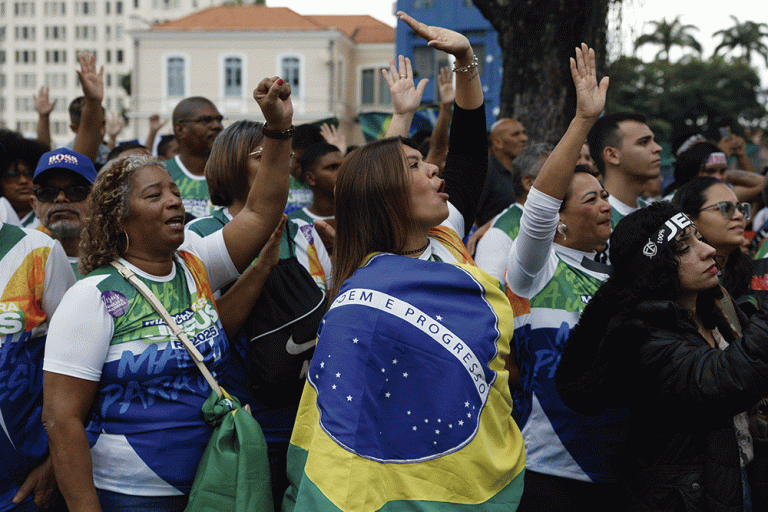
No campo evangélico tradicional (e também fora dele), surpreendeu a incomum dobradinha entre Jorge Messias e André Mendonça, ministro do STF indicado por Bolsonaro em 2021, após intensa campanha junto à base religiosa conservadora. O magistrado “terrivelmente evangélico”, ligado à Igreja Presbiteriana e ex-titular da Advocacia-Geral da União, tem procurado colegas da Corte e senadores para afirmar que, entre os nomes cogitados para suceder a Barroso, Messias é seu favorito.
O contato entre o atual e o provável futuro ministro foi facilitado por parlamentares como o deputado Cezinha, ex-presidente da Frente Parlamentar Evangélica, e o senador Jaques Wagner, para quem Messias já trabalhou como chefe de gabinete. A aproximação começou, porém, quando Mendonça disputava sua vaga no STF, e Messias atuou junto a senadores do centro e da esquerda para superar resistências ao bolsonarista. Agora, Mendonça deve retribuir. “Nunca criamos problemas para a indicação de Messias. Temos respeito e carinho por ele, que é um grande jurista. Tenho certeza de que Mendonça ajudará o Messias”, afirma o advogado Marco Aurélio de Carvalho, coordenador do Grupo Prerrogativas.
Curiosamente, a maior resistência à indicação de Mendonça em 2021 partiu do presidente do Senado, Davi Alcolumbre (União Brasil), o mesmo que agora se opõe a Messias. Na época, o senador articulava em favor do então procurador-geral da República, Augusto Aras. Desta vez, seu preferido é o também senador Rodrigo Pacheco (PSD). Ainda assim, o martelo foi batido a favor de Messias em uma reunião entre Lula e Alcolumbre, na terça-feira 21. Coincidência ou não, na véspera do encontro, o Ibama autorizou a Petrobras a iniciar testes de exploração no bloco FZA–M–59, na Margem Equatorial, a cerca de 500 quilômetros da Foz do Rio Amazonas e a 175 da costa do Amapá. De olho nos royalties do petróleo, que podem beneficiar seu estado, Alcolumbre tem especial interesse na liberação da licença.
Antes de viajar para a Ásia, Lula comunicou ao presidente do Senado sobre sua decisão
Recorrendo a um bem-humorado trocadilho, o advogado e procurador de Justiça aposentado Lenio Streck diz que Lula vai “matar dois coelhos com uma ‘messiada’ só”, ao indicar o advogado-geral da União ao STF. “O presidente nomeia um ministro qualificado e alinhado com o governo, e ainda conquista um trunfo na difícil missão de aproximar a esquerda dos evangélicos.” Para Streck, professor de Direito Constitucional na Unisinos e pós-doutor pela Universidade de Lisboa, Messias é um jurista calejado nas disputas institucionais. “Na AGU, Messias mostrou-se uma espécie de camisa 10 do governo. Ministros da Justiça e advogados-gerais levam vantagem por lidarem diretamente com os temas mais sensíveis da República. Messias soma a isso um elemento muito brasileiro: o peso das religiões.”
Deputado federal pelo PSOL, o pastor Henrique Vieira avalia que a indicação de Messias pode acenar aos conservadores, mas não necessariamente à base evangélica como um todo. “É um erro supor que o diálogo com os fiéis se dá apenas pelo conservadorismo.” alerta. “Generalizar esse campo e pensar que dialogar é sempre ceder, e não debater com respeito às diferenças, é um equívoco. É a repetição de uma estratégia fracassada, que depois é apropriada pela direita.”
Para Vieira, o governo não deve limitar-se ao diálogo com grandes lideranças religiosas, mas buscar uma conexão direta com a base evangélica, que é plural e diversa. “Não se trata de um bloco homogêneo. Pautas socioeconômicas como emprego, renda, isenção do Imposto de Renda e direito à moradia falam diretamente com esse público, que compõe a classe trabalhadora”, afirma. O deputado destaca ainda a importância de evitar a “partidarização dos púlpitos” e elogia a postura de Lula, que tem cobrado da esquerda um diálogo mais amplo com os eleitores cristãos. “Essa atitude tende a gerar respeito entre os fiéis. É um caminho possível de aproximação.”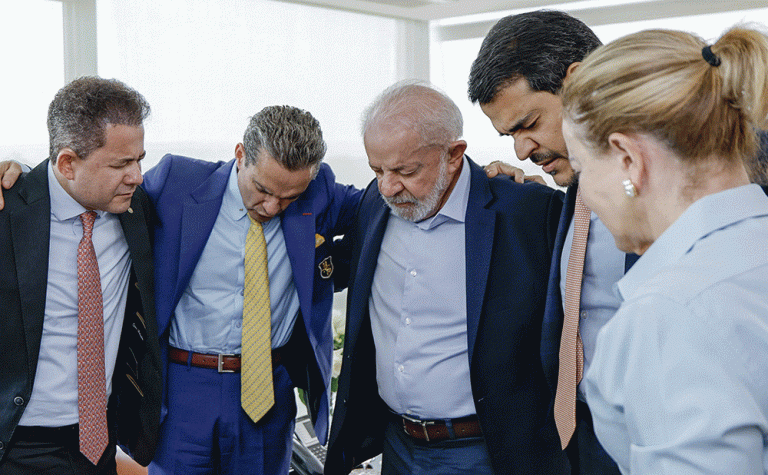
Nos últimos dias, Lula voltou a comentar a relação política com os evangélicos. Durante um congresso do PCdoB, afirmou que “2026 será um ano sagrado” e que a esquerda precisa “agir de forma diferente” ao dialogar com o segmento. “Os evangélicos não são contra nós – nós é que não sabemos conversar com eles. O erro é nosso. Nos distanciamos do povo. Nossa linguagem e nosso discurso estão muito longe da compreensão de milhões que gostariam de nos ouvir. O desafio é convencer quem ainda não está conosco a caminhar ao nosso lado”, disse.
A ordem no governo e no PT é reconstruir antigas pontes – e erguer novas – com o eleitorado evangélico. A um ano das eleições, quem assume protagonismo nessa missão é a primeira-dama, Janja da Silva. Neste mês, ela participou, em Caruaru, do sétimo encontro promovido pela Frente de Evangélicos pelo Estado de Direito com mulheres cristãs. Outros já ocorreram em Brasília, Salvador, Manaus e Rio de Janeiro. Católica, Janja destacou em suas redes sociais a “potente troca de experiências” nas reuniões. “Momentos como esse, de escuta e compartilhamento de vivências, encorajam cada uma de nós a seguir de cabeça erguida.”
Coordenadora da Frente e organizadora do primeiro encontro, realizado no Rio, Nilza Valéria Zacarias diz que as mulheres têm recebido bem o diálogo com a primeira-dama. “Elas querem ser ouvidas sobre o trabalho que realizam em suas igrejas e comunidades, aliviando o sofrimento de quem mais precisa. São elas que acolhem outras mulheres, distribuem alimentos e promovem atividades no contraturno escolar, para afastar crianças das ruas. As conversas têm girado em torno de necessidades concretas, solidariedade e políticas públicas que gerem oportunidades.”
Nilza Zacarias destaca que Janja é uma aliada importante na promoção de políticas públicas. Ela lembra ainda que, nas periferias, cresce o número de mulheres que frequentam igrejas: “Faz todo sentido dialogar com elas. Nenhuma mulher é apenas evangélica. Ela também é mãe, trabalhadora, cuidadora, empreendedora. As igrejas funcionam como espaços de organização social, onde essas diferentes dimensões se encontram”.
Janja e benedita têm participado de encontros com mulheres evangélicas
Estrela do programa radiofônico Papo de Crente e também coordenador da Frente, o pastor Ariovaldo Ramos afirma que os encontros entre mulheres evangélicas e a primeira-dama têm sido positivos, sobretudo por promoverem conhecimento mútuo. Ele ressalta, porém, que o propósito da entidade – defensora do Estado laico – nunca foi estabelecer um canal direto com o governo. “Nosso objetivo é mostrar aos fiéis que as chamadas pautas de esquerda são as que mais se alinham com a mensagem de Cristo. Criamos o programa de rádio, publicamos revistas temáticas com base no estudo bíblico e realizamos encontros para aprofundar esse debate”, explica.
Presente no evento com Janja no Rio, a deputada federal Benedita da Silva (PT) avalia que os encontros aproximam o governo dos evangélicos e ajudam a esclarecer a relação entre fé, cidadania e política. “Um exemplo é a compreensão de que a Declaração Universal dos Direitos Humanos se inspira na Bíblia e nos valores cristãos”, diz. Integrante do núcleo evangélico do partido, a parlamentar reforça que “a fé sem obras é morta” e defende a coerência entre discurso e prática. “A palavra deve estar alinhada à melhora das condições de vida do povo e à soberania nacional. Do contrário, perde o sentido.”
Benedita é uma das apostas de Lula para conquistar o eleitorado evangélico na campanha do próximo ano. O presidente é o principal fiador da sua candidatura ao Senado, um apoio decisivo na disputa interna do PT no Rio. Para a deputada, o diálogo com esse público deve respeitar e valorizar a fé, além de reconhecer que as igrejas são comunidades que oferecem não apenas suporte espiritual, mas também oportunidades de trabalho e assistência aos mais vulneráveis. “O PT precisa mostrar, com dados concretos, as políticas públicas que fortalecem a família e esclarecer que Lula jamais combateu qualquer religião, muito pelo contrário”, afirma, citando iniciativas como a Lei da Liberdade Religiosa e a oficialização do Dia do Evangélico e da Marcha para Jesus. “Esses fatos incontestáveis comprovam que Lula e o PT nunca perseguiram os evangélicos e demonstram que a liberdade religiosa, tão valorizada por nós, só é garantida quando o Estado é laico, conforme determina a Constituição.”
Gleisi Hoffmann foi designada por Lula para ampliar o diálogo com “pastores progressistas” e parlamentares evangélicos de esquerda e centro. A ministra também coordena o esforço de outros ministros com boa relação junto a esse público, como Wellington Dias (Desenvolvimento Social) e Anielle Franco (Igualdade Racial). Nas conversas dos últimos dois meses, Hoffmann recebeu várias propostas e sugestões sobre a postura do governo. Entre as ideias apresentadas ao presidente estão a realização de um encontro nacional com evangélicos e a criação de uma assessoria especial para esse segmento na estrutura governamental. “As demandas estão na mesa”, diz.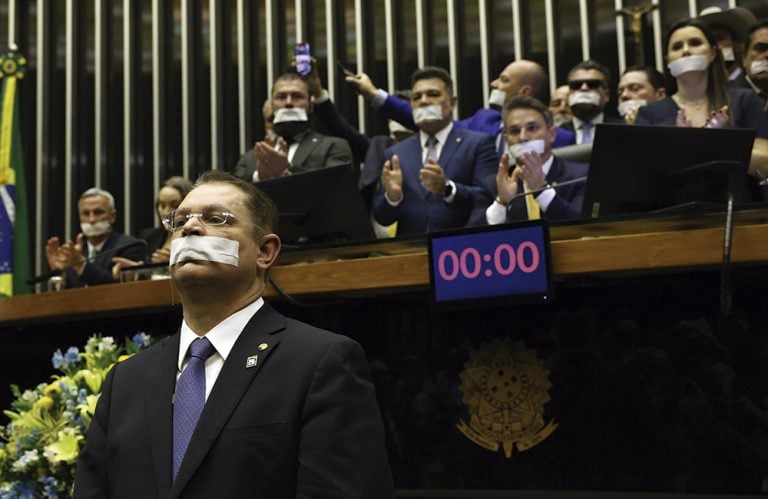
No PT, a aproximação com o eleitorado evangélico passa pela Setorial Evangélica e pela Fundação Perseu Abramo. Em maio, a instituição ligada ao partido ofereceu aos militantes o curso “Fé e Democracia para Evangélicos e Evangélicas”, com o objetivo de preparar filiados para dialogar com esse segmento. Para as eleições municipais de 2024, o PT distribuiu uma cartilha orientando seus candidatos em todo o País sobre como se relacionar com os fiéis. O material destacava “o que fazer”, como valorizar a fé e a família, defender a verdade e os direitos humanos, falar sobre liberdade religiosa e ressaltar leis aprovadas pela legenda. Já as orientações sobre “o que não fazer” incluíam críticas a pastores e a cultos, menções a fundamentalismo e citações exageradas da Bíblia.
No que depender da vontade de algumas de suas lideranças, o PT ainda vai ter uma igreja evangélica pentecostal para chamar de sua. Vice-presidente nacional do partido, o prefeito de Maricá, Washington Quaquá, está montando na cidade fluminense a Igreja Jesus Libertador, que, segundo ele, terá uma orientação progressista. Quaquá defende que a disputa da narrativa política no meio evangélico não deve ficar restrita a pastores, muitos deles alinhados ao bolsonarismo. “O PT é um partido do povo e abriga diversas religiões, contando com muitos evangélicos entre seus filiados”, observa. “Precisamos ouvir e organizar a nossa base evangélica.”
O prefeito destaca a afinidade entre o discurso petista e os valores cristãos: “Temos todos os princípios de solidariedade e defesa dos pobres. Somos mais cristãos do que muitos que fazem estardalhaço se dizendo cristãos. Por isso, toda iniciativa de aproximação com as igrejas evangélicas é muito positiva”. Questionado por CartaCapital sobre se a “igreja petista” estará funcionando durante as eleições do ano que vem, Quaquá responde: “A Igreja Jesus Libertador já foi criada e está se estruturando. Aguardem”. •
CARTA CAPITAL
Uma engrenagem planetária disciplinada movimenta a extrema-direita
Por Celso Pinto de Melo ...
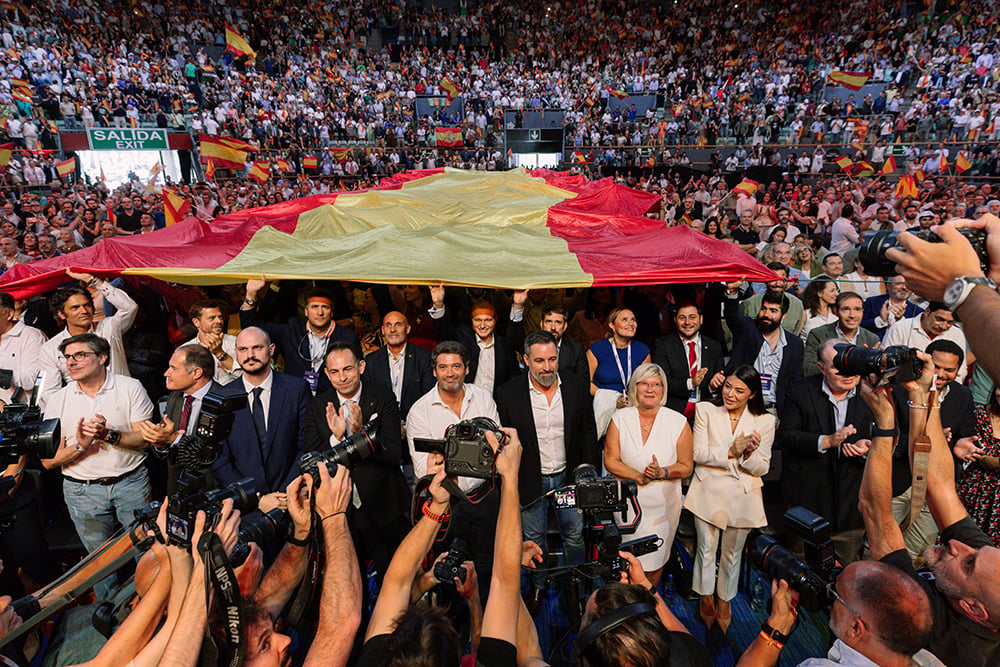
....
E nos tensos interregnos das transições entre o velho que se recusa a desaparecer e o nascer de novos tempos que fenômenos mórbidos proliferam. A política da extrema-direita, nos Estados Unidos ou no Brasil, é muitas vezes tratada como incoerente e irracional. É fácil zombar de seus rituais: pedidos de auxílio a extraterrestres, invocações ao AI-5 em meio a bandeiras verde-amarelas, a invasão do Capitólio com fantasias de viking. Tudo parece improviso de lunáticos. Por trás da aparência de caos, há, no entanto, uma engrenagem internacional disciplinada, operando com objetivos claros e articulada por think tanks ultraconservadores, como a Heritage Foundation.
Documentos como o Project 2025 e o Project Esther são faces complementares dessa estratégia. O primeiro organiza um manual para a captura do aparelho de Estado, o segundo mobiliza pânicos morais enraizados em interpretações religiosas. Ambos se apoiam em redes transnacionais que conectam igrejas, partidos, agências de desinformação e até editoras evangélicas brasileiras, como a Casa Publicadora das Assembleias de Deus. O objetivo é reconfigurar as democracias liberais, submetendo o Estado a uma moral religiosa conservadora, restringindo direitos civis e reinstalando uma ordem social hierarquizada sob o pretexto da defesa da liberdade.
Nos EUA, o Project 2025 propõe demissões em massa no serviço público, substituindo técnicos por militantes ideológicos, a fusão ou extinção de agências ambientais e educacionais, a imposição do nacionalismo cristão como doutrina oficial, o uso do Insurrection Act de 1807 para reprimir protestos e o desmonte de políticas de diversidade e inclusão. Algumas medidas foram testadas no governo Trump, como a saída do Acordo de Paris e os cortes em agências reguladoras. No Brasil de Bolsonaro, práticas semelhantes se expressaram no aparelhamento de órgãos públicos, no ataque a instâncias de controle e na disseminação sistemática do ódio e da desinformação.
A engrenagem não se restringe ao eixo EUA–Brasil. Ela conecta-se em eventos como as Conferências de Ação Política Conservadora, que reúnem líderes como Viktor Orbán, Giorgia Meloni, Santiago Abascal e Javier Milei em torno de uma pauta comum. Trata-se de uma internacional autoritária que compartilha métodos, recursos e legitimidade simbólica. Um alvo central é a produção de conhecimento crítico. A ofensiva anticiência desqualifica universidades, cientistas e educadores, promovendo teorias conspiratórias sobre gênero, globalismo, vacinas e clima. Pretende não apenas privatizar a educação, mas colonizar os currículos com dogmas, esvaziando as humanidades e enfraquecendo a capacidade de questionar o estabelecido.
O Project Esther, por sua vez, articula a dimensão religiosa. Enraizado na doutrina escatológica do dispensacionalismo, vê o Estado de Israel como cumprimento de profecias e transforma a política externa em ato de fé. Nos EUA, organizações como a Christians United for Israel dão corpo a essa visão. No Brasil, ela se difunde por meio de igrejas como a Assembleia de Deus, o Ministério Internacional da Restauração e a Sara Nossa Terra, impulsionada por lideranças como Silas Malafaia, Marco Feliciano, René Terra Nova, Robson Rodovalho e Damares Alves. Esse discurso confere uma pretensa superioridade moral às alianças entre fé e mercado político, criando justificativas religiosas para agendas autoritárias. No Brasil, esse roteiro ganhou expressão simbólica. O patrimônio cívico foi sequestrado e convertido em estandartes de guerra cultural. A bandeira verde e amarela passou a ser usada ao lado daquelas de Israel e dos EUA, compondo uma iconografia que associa nacionalismo a religiosidade e subordinação geopolítica.
Uma internacional autoritária compartilha táticas, recursos e legitimidade simbólica
Eduardo Bolsonaro desempenha papel ativo como elo entre a CPAC brasileira e a Heritage Foundation, além de participar de eventos ligados ao sionismo cristão, projetando o Brasil como parte da mesma rede internacional. A Frente Parlamentar Evangélica reforça a lógica no Legislativo, enquanto o discurso fundamentalista serve como instrumento para minar a laicidade e os direitos civis. Nada disso é improviso: o ruído é tático. Escândalos performáticos funcionam para confundir, atrair atenção e deslegitimar o debate racional, enquanto o aparelho de Estado é manipulado nos bastidores.
Um aspecto adicional precisa ser destacado: o “método” não reside apenas nas instituições formais, mas também no ecossistema digital. Plataformas como Facebook, Twitter/X, YouTube e TikTok se consolidaram como canais de difusão de pânico moral e mobilização militante. Controlados por poucas big techs, seus algoritmos amplificam conteúdos polarizadores e premiam a desinformação e o discurso de ódio. A disputa não ocorre apenas no Congresso ou nas ruas, mas no espaço digital. Campanhas como o Brexit, a eleição norte-americana de 2016 e os disparos em massa no WhatsApp em 2018 no Brasil inauguraram uma era em que a manipulação das redes digitais é parte central do roteiro global. Nesse contexto, a aliança recente entre CEOs das big techs e a extrema-direita não é contingente, mas estratégica: redefine a esfera pública ao flexibilizar a moderação, amplificar o extremismo e contornar regulações. O resultado é um espaço assimétrico, onde algoritmos e infraestrutura privada se transformam em armas políticas, fragilizando a democracia, a ciência e as soberanias nacionais.
Não podemos nos deixar petrificar pelos olhares dessa Medusa. Assim como Perseu, para derrotá-la é preciso identificar suas limitações e tensionar suas vulnerabilidades. O que está em jogo vai além de eleições. É a própria estrutura democrática e laica da vida pública que se encontra sob ataque. Universidades, imprensa, agências reguladoras, direitos de minorias e o princípio da igualdade perante a lei são alvos preferenciais. A soberania nacional também é corroída, seja pelo alinhamento automático a interesses externos, pelo negacionismo climático ou pelo armamentismo travestido de nacionalismo. O resultado é um projeto de submissão sob a aparência de independência. Resistir a essa ofensiva não significa imitá-la em intolerância ou autoritarismo, mas fortalecer as vias democráticas. Isso implica defender a ciência, a educação pública e o pensamento livre, revitalizar órgãos de controle e agências reguladoras, reconquistar símbolos nacionais como patrimônio plural, denunciar o uso político da fé e reafirmar a laicidade do Estado como pilar de uma democracia inclusiva. •
CARTA CAPITAL
No ano passado, o planeta atingiu o maior patamar de gastos bélicos em mais de 30 anos. Foram 2,7 trilhões de dólares, aumento de 9,4% em relação a 2023. Estados Unidos, China, Rússia, Alemanha e Índia lideram o ranking, nessa ordem, e respondem, juntos, por 60% do total global. Em termos de crescimento porcentual, a nova corrida às armas é puxada por uma Europa que interpreta a invasão da Ucrânia como prenúncio de uma ação hostil da Rússia contra o continente. A sensação de insegurança europeia ganhou novo impulso após o presidente norte-americano, Donald Trump, ter se aproximado de Vladimir Putin, dando sinais de que o apoio dos EUA à Otan não é tão sólido e inquestionável como no passado. Mais recentemente, os voos de drones russos sobre países europeus tornaram ainda mais palpável a previsão de uma guerra, justificando a mobilização de recursos que agora consumirão o equivalente a ao menos 2% do PIB das nações do Velho Continente.
Na América Latina, as ações hostis dos EUA contra a Venezuela e o Brasil acenderam a luz amarela. Desde os anos 1960, a região não se sentia tão explicitamente fustigada pelos norte-americanos. No caso brasileiro, a hostilidade veio na forma de sanções unilaterais contra integrantes do Supremo Tribunal Federal envolvidos no julgamento do ex-presidente Jair Bolsonaro e na imposição de altas taxas contra exportações de uma série de produtos. Uma conversa entre os presidentes Lula e Trump na segunda-feira 6 abriu, porém, uma via de negociação antes inexistente entre as duas maiores economias do continente. Na Venezuela, o caso é ainda mais grave, com os EUA a deslocar tropas para o Caribe, perto da costa do país governado por Nicolás Maduro, a quem prometeram derrubar com o uso da força.
Em 2024, os investimentos bélicos passaram de 2 trilhões de dólares
A inesperada militarização do entorno brasileiro e a escalada de declarações e atos inamistosos dos norte-americanos contra o Brasil ocorreram pouco antes de o ministro da Defesa, José Múcio, defender o aumento dos gastos militares. Em 30 de setembro, Múcio foi ao Senado reclamar dos atuais 135 milhões de reais previstos para a pasta em 2025. “Eu vim atrás de ajuda”, implorou aos integrantes da Comissão de Relações Exteriores e Defesa Nacional, explicando que “a diplomacia e a defesa são como irmãs inseparáveis: duas armas à disposição do Estado para vencer a guerra da sobrevivência neste mundo de constantes transformações”.
A declaração é um eufemismo para as ameaças que o Brasil começa a perceber de forma mais clara contra si e em seu entorno. Semanas antes, o ministro de Minas e Energias, Alexandre Silveira, havia dito, na cerimônia de posse dos novos diretores da Autoridade Nacional de Segurança Nuclear, no Rio de Janeiro, que “arroubos internacionais muito graves no mundo” atual justificariam o Brasil pensar no uso da tecnologia atômica “também para a defesa nacional”. “Um país como o nosso – prosseguiu o ministro –, que tem 11% da água doce do planeta, clima tropical, solo fértil e tantas riquezas minerais, precisa levar muito a sério a questão nuclear.” Na sequência, o ministério divulgou nota criticando o que chamou de “especulação” em torno das declarações do titular da pasta, e lembrou que o Brasil cumpre com suas obrigações nacionais e internacionais contra as armas atômicas.
As obrigações às quais a pasta se refere estão inscritas na Constituição de 1988, que proíbe o uso da energia nuclear para fins militares. O País resiste, no entanto, em aderir a documentos internacionais que reforçariam essa obrigação. O principal deles é o Tratado Sobre a Proibição de Armas Nucleares, que o Brasil assinou em 2017, mas ainda não ratificou. Para levar esse processo de adesão até o fim, o documento teria de passar pelo Congresso, mas se encontra retido nas mãos do relator, o deputado federal Luiz Philippe de Orleans e Bragança (PL–SP), que disse a CartaCapital ter “urgência zero” na tramitação. “O Brasil precisa de autonomia, tecnologia e coragem para enfrentar o mundo como ele é, não como alguns idealistas gostariam que fosse”, afirmou o parlamentar em seu voto contrário à adesão ao tratado internacional que busca impedir a fabricação, estocagem, uso ou transferência de armas nucleares no mundo.
Para Cristian Wittmann, professor da Universidade Federal do Pampa, o aumento mundial de gastos militares é uma resposta “aos conflitos em curso e ao enfraquecimento do Direito Internacional e do multilateralismo”. Na avaliação do acadêmico, também integrante da Campanha Internacional pela Abolição das Armas Nucleares, organização vencedora do Nobel da Paz em 2017, há hoje uma falta de confiança nos mecanismos criados para prevenir e coibir as guerras, o que faz com que os países voltem a considerar as armas nucleares como “uma forma nacional de afastar a interferência externa”. No caso do Brasil, Wittmann vê um “distanciamento dos princípios históricos brasileiros, de afastar o uso militar da energia nuclear”. Ele enxerga “uma contradição por parte de um governo que diz querer fortalecer o multilateralismo, mas que adota uma postura nacionalista, de aumentar o próprio gasto militar”, como pediu Múcio em sua visita ao Congresso.
Quando falam em aumento de gastos, em todo caso, políticos e militares brasileiros mencionam sempre investimentos em tecnologia de ponta, como os caças Gripen comprados da Suécia e os submarinos com propulsão nuclear, construídos em parceria com a França, mas a verdade é que 78% do total é consumido com pessoal. Nos EUA, esse porcentual é de apenas 22%. Entre salários da ativa e pensões, o País gastou 77,4 bilhões de reais em 2024 com as Forças Armadas. •
CARTA CAPITAL
POR JOÃO PAULO CHARLEAUX...

O professor australiano Carl Rhodes examina o mito do “bom bilionário” e o processo de legitimação das fortunas
Por Leonardo Moura
O professor australiano Carl Rhodes examina o mito do “bom bilionário” e o processo de legitimação das fortunas
Por Leonardo Moura

Os palestinos serão privados de suas escolhas, mas os negócios têm tudo para prosperar
Por Arturo Hartmann e Sergio Lirio ...
Exatos dois anos depois do ignominioso atentado do Hamas que deixou um rastro de 1,2 mil judeus mortos e foi o estopim para uma vingança selvagem de Israel, elevada ao patamar de genocídio, conforme as conclusões recentes dos especialistas a serviço das Nações Unidas, um cessar-fogo na Faixa de Gaza foi anunciado na noite da quarta-feira 8 pelo presidente dos Estados Unidos, Donald Trump, principal fiador das negociações. Embora os termos do acordo de longo prazo apresentado pelo republicano favoreçam, sem nenhum pudor, o aliado Benjamin Netanyahu e continuem absolutamente vagos, as circunstâncias dificultaram qualquer tentativa de sabotagem das partes envolvidas. Diante do cenário de terra arrasada, da morte de quase 70 mil palestinos, segundo cálculos subestimados, e do desespero cotidiano dos sobreviventes submetidos ao racionamento de água, comida e remédios, confinados em um campo de concentração a céu aberto, o Hamas se viu em um beco sem saída. Netanyahu e a ala de extrema-direita que o apoia, por sua vez, estavam sob pressão crescente de aliados ocidentais, cada vez mais incomodados com os crimes de guerra em curso no enclave, e dos próprios eleitores, ansiosos pela volta dos reféns.
As negociações no balneário de Sharm el-Sheikh, no Egito, duraram dois dias. A chegada de Steve Witkoff, enviado da Casa Branca para Oriente Médio, Jared Kushner, genro do presidente e um dos elaboradores do plano, e Ron Dermer, principal conselheiro de Netanyahu, na quarta-feira 8 foi o prenúncio de um desfecho iminente e positivo das conversas. Na noite do mesmo dia, Trump anunciou os termos iniciais do acordo. O Hamas se compromete a libertar 20 reféns ainda vivos na primeira fase, em troca de 2 mil prisioneiros palestinos em poder de Israel, 250 dos quais condenados à prisão perpétua, e 1,7 mil detidos durante a invasão ao enclave. As ruas de várias cidades israelenses e em Gaza foram tomadas por celebrações. “Não sou o único feliz, toda a faixa está feliz, todo o povo árabe, todo mundo está feliz com o cessar-fogo e o fim do derramamento de sangue”, afirmou à agência de notícias Reuters Abdul Majeed Abd Rabbo, morador de Khan Younis, uma das localidades palestinas mais arrasadas pelos ataques israelitas. Tel-Aviv também concordou em iniciar a retirada das tropas e a permitir a entrada de ajuda humanitária. Quando? Depende da aprovação dos demais integrantes do governo. “Ao contrário dos relatos da mídia árabe, a contagem regressiva de 72 horas começará somente após o acordo ser aprovado na reunião de gabinete”, afirmou Netanyahu, em uma tentativa de demonstrar algum controle da situação.
Trata-se de um começo alvissareiro para um cessar-fogo de longo prazo, após sucessivos fracassos, mas o problema continua a ser o meio e o fim do acordo. Para Shawan Jabarin, diretor da Al-Haq, organização palestina de direitos humanos, o problema central do que ele chama de “ultimato de Trump aos palestinos” é que ele “condiciona a suspensão dos contínuos ataques genocidas de Israel e o extermínio em massa dos palestinos em Gaza a um conjunto de termos unilaterais ditados pelos Estados Unidos”. De fato, na ocasião do anúncio do plano, feito ao lado de Netanyahu após uma reunião na Casa Branca, o presidente norte-americano afirmou que, caso o grupo palestino não aceitasse o acordo, Israel teria “total apoio para acabar com o trabalho de destruir a ameaça”. Condicionar a entrada de ajuda humanitária à aceitação dos termos, prossegue Jabarin, é um prêmio à ilegalidade sem limites cometida por Israel. O ativista refere-se aos itens 7 e 8 do documento de 20 pontos, segundo os quais a entrada imediata de ajuda humanitária será coordenada por agências internacionais logo após a assinatura do acordo.
A questão mais controversa da proposta continua a ser o mapa da retirada do exército israelense, que atualmente controla 82% de Gaza, sob zonas militares e ordens de evacuação. No item 16 do documento, a saída é subordinada a “marcos ligados à desmilitarização” dos grupos palestinos, definidos em conjunto por Israel, a Força Internacional de Segurança que vier a ser formada e os países garantidores do acordo. Khalil al-Hayya, representante do Hamas no Egito e um dos sobreviventes do ataque israelense a um prédio em Doha, no mês passado, afirma que o grupo mantém a exigência de retirada completa dos soldados judeus, o que incluiria a zona do perímetro, uma faixa na fronteira de Gaza criada por Israel, e do Corredor Philadelphi, na divisa com o Egito. Seja para agradar ao público extremista interno, seja para complicar as negociações, Netanyahu tem declarado estar fora de cogitação a retirada total das Forças Armadas do território.
De acordo com a rede de tevê Al Jazeera, baseada em informações de oficiais do Hamas, os debates principais na terça-feira 7 giraram em torno da libertação dos reféns israelenses ainda em poder do grupo e a retirada do exército israelense. O Hamas tenta vincular a devolução de reféns às etapas de desmilitarização do território. Dessa maneira, o último sequestrado seria devolvido quando o último soldado deixasse o enclave. Isso pode ser um problema, pois o item 4 do plano determina que “dentro de 72 horas depois de Israel publicamente aceitar o acordo, todos os reféns, vivos e mortos, serão devolvidos”. Não só. Trump deseja criar um momento épico de libertação de todos os reféns, uma fotografia para projetar a imagem de líder “pacifista” e reforçar sua campanha particular – e obsessiva – pelo Prêmio Nobel da Paz. Dará tempo? O vencedor ou os vencedores da premiação seriam anunciados na sexta-feira 10, depois do fechamento desta edição.
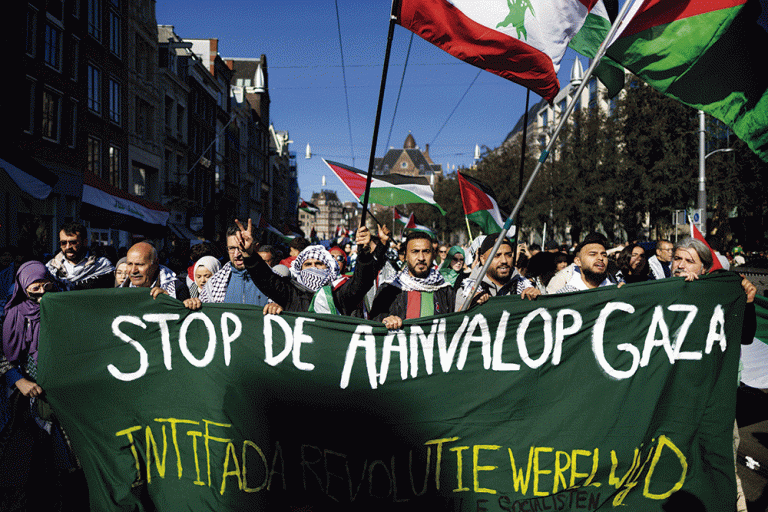
O cronograma de retirada das tropas era um impasse esperado nas discussões, principalmente depois da revelação de que o item 16 do plano havia sido ajustado por imposição de Netanyahu, uma alteração feita sem o conhecimento das lideranças árabes que tinham concordado em apoiar os termos anteriores apresentados pelo presidente dos EUA durante uma reunião privada na Assembleia-Geral da ONU. A mudança deu a Tel-Aviv o poder de se negar, de forma unilateral, a desmilitarizar o território caso constate, segundo seus critérios, que as ameaças não tenham cessado.
Se olhassem para o passado, os negociadores de agora perceberiam que a estratégia de dar vantagem a um dos lados, em geral a Israel, foi testada e fracassou. Em 1993, no famoso Acordo de Oslo, prevaleceu a fórmula “terra por paz”, ou seja, os israelenses retirariam exército e colonos gradualmente dos territórios ocupados à medida que os palestinos garantissem a segurança aos israelenses. Em outras palavras, feito o desmonte de qualquer tipo de resistência às arbitrariedades de Tel-Aviv. Deu-se o contrário. Com o enfraquecimento dos “inimigos”, Israel ampliou a ocupação e transformou em permanente o que era temporário. Ainda assim, os mediadores árabes e islâmicos, Catar, Egito e Turquia, insistiram para o Hamas aceitar o plano. Os líderes desses países teriam dito ao grupo tratar-se da última chance de um acordo. “Você não pode rejeitar um acordo com Trump, não importa o quanto esteja insatisfeito com alguns de seus termos”, resumiu, de forma anônima, um dos negociadores.
O Acordo de Oslo é ilustrativo da prevalência da retórica sobre a realidade. O tratado assinado na capital da Noruega foi recebido com entusiasmo semelhante ao plano de Trump. As três figuras centrais das negociações, Yitzhak Rabin, primeiro-ministro israelense, Shimon Peres, chanceler do país, e Yasser Arafat, presidente da Organização para a Libertação da Palestina, foram agraciados com o Nobel da Paz (talvez esse fato explique a obsessão do atual presidente dos EUA). A paz, de fato, nunca saiu do papel. Em 2001, a respeito do acordo, o longevo Netanyahu, responsável agora por cumprir o novo acerto, declarou: “Perguntaram-me antes da eleição se eu honraria… Eu disse que sim, mas que interpretaria os acordos de tal forma que me permitisse pôr fim a esse galope em direção às fronteiras de 1967. Como fizemos isso? Ninguém disse o que eram zonas militares definidas. Zonas militares definidas são zonas de segurança. No que me diz respeito, todo o Vale do Jordão é uma zona militar definida”.
Jared Kushner, genro de Trump, é crucial no plano de reconstrução de Gaza, que vai movimentar bilhões de dólares
O sinal verde dado pelos países árabes e pela Turquia foram, de qualquer maneira, um trunfo do presidente dos Estados Unidos. “Eu falei com o presidente Erdogan, ele é fantástico”, afirmou o republicano, sem perder a paixão por superlativos. “Ele está forçando bastante, ele é um cara poderoso. O Hamas tem muito respeito por ele. Eles têm muito respeito pelo Catar, pelos Emirados Árabes e pela Arábia Saudita”. O grupo palestino parece, no entanto, ter captado o espírito do plano norte-americano. Em entrevista ao Drop Site News, uma liderança do Hamas resumiu: “Essa proposta não foi apresentada para encontrar um fim para a guerra. Ou é a rendição total ou a continuação da guerra. É pegar ou largar”. A direção considera os termos “catastróficos, no curto e longo prazo, para a resistência e para toda a causa palestina”, mas sabe que a tragédia humanitária erodiu o apoio popular interno e o poder de influência nas conversas diplomáticas. Restavam duas alternativas: ou a entrega das armas ou assistir ao extermínio do que resta de palestinos em Gaza.
Apesar do horizonte político pouco promissor para a população local, o plano de Trump contraria em certa medida os radicais de direita de Israel, entre eles Bezalel Smotrich, ministro das Finanças, cujo intuito era ocupar o enclave de forma definitiva depois de concluída a limpeza étnica. Trump estava inclinado a apoiar essa ideia, mas acabou convencido do contrário em uma reunião, no fim de agosto, da qual participaram Kushner, Witkoff e Tony Blair, ex-primeiro-ministro britânico cotado para liderar a administração tecnocrática de reconstrução de Gaza. O trio convenceu o presidente dos EUA de que a expulsão em massa de palestinos “não era necessária nem sábia”. E sugeriram ao republicano investir nas relações com os demais países do Oriente Médio em busca de uma solução para o conflito. O ataque israelense a um prédio em Doha em 9 de setembro, em uma caçada a lideranças do Hamas, criticada pela Casa Branca, afastou um pouco mais Trump de Netanyahu. Como resposta, a Casa Branca ofereceu um mimo aos cataris, por meio da ordem executiva “Assegurando a Segurança do Estado do Catar”, que inclui ação militar para proteger a integridade territorial do país no caso de ataque estrangeiro.
Não menos importante, há o fator Kushner na dinâmica do esforço diplomático. O genro de Trump esteve ligado à formulação, ao lado de Blair, do “Fundo de Reconstituição, Aceleração Econômica e Transformação de Gaza (GREAT, na sigla em inglês), que circulou entre políticos no primeiro semestre do ano. Em linhas gerais, o GREAT (acrônimo típico da grandiloquência trumpiana) apontava os “benefícios estratégicos” para os EUA da tomada de Gaza: “Ganhos massivos de dólares, acelerar o IMEC (Corredor Índia–Oriente Médio–Europa, rota dos EUA para competir com a China), solidificar a arquitetura regional abraâmica (normalização da relação de países árabes com Israel), fortalecer o punho sobre o Mediterrâneo oriental e assegurar à indústria dos EUA o acesso a 1,3 bilhão de dólares em terras-raras do Golfo”. Kushner mantém fortes ligações com o fundo público de investimento do governo da Arábia Saudita. No mesmo dia do anúncio do “plano de paz”, ele divulgou a compra da Electronic Arts, empresa desenvolvedora de videogames, por 55 bilhões de dólares, por meio de sua companhia, a Affinity Partners, em sociedade com o fundo Silver Lake e o FPS. A vida dupla de investidor e diplomata tem rendido acusações de conflito de interesse ao genro de Trump. O senador democrata Ron Wyden, de acordo com o Le Monde, já perguntou a Kushner sobre o recebimento de polpudos depósitos do fundo saudita.
Além dos interesses familiares e da obsessão pelo Nobel da Paz, interferir no conflito entre Israel e a Palestina ecoa a estratégia de Trump condensada no chamado “Projeto 2025”, que norteou sua campanha presidencial. O capítulo “Departamento de Estado”, de autoria de Kiron Skinner, integrante dos Institutos Hover e Heritage, centros do pensamento reacionário, e ex-diretora de Planejamento de Políticas no primeiro governo do magnata, afirma que, em um escopo maior, “os EUA devem impedir o Irã de adquirir tecnologia nuclear e capacidade de lançamento (da bomba), e, mais amplamente, bloquear as ambições iranianas”. Entre as sugestões, além da reinstituição das sanções, estão “prover assistência de segurança para parceiros regionais” e “assegurar que Israel tenha tanto os meios militares quanto o apoio político e a flexibilidade para tomar as medidas que acreditar necessárias para se defender do regime iraniano e de seus proxies regionais, como Hamas, Hezbollah e a Jihad Islâmica Palestina”. A sugestão de Skinner tornou-se uma profecia autorrealizada, pois a pressão de Trump sobre o Irã chegou ao ponto de um ataque coordenado com Israel, incluindo a tentativa de decapitar a liderança militar e destruir usinas nucleares. Outro elemento estratégico para os EUA, e Israel, é retomar os Acordos de Abrãao, interrompidos em outubro de 2023, mas que poderiam ser reavivados a partir do consenso regional formado em caso de um eventual sucesso do plano de cessar-fogo.
Mesmo entre os judeus dos EUA o apoio a Israel é declinante
O isolamento crescente de Netanyahu facilitou as negociações. Até mesmo a Casa Branca, parceira incondicional, demonstrou algum grau de irritação. No domingo 5, antes do início das negociações e por conta de uma certa ambivalência do primeiro-ministro israelense, o presidente dos Estados Unidos passou uma carraspana no aliado, segundo relatos do site Axios. “Eu não sei por que você é sempre tão (fucking) negativo… Isto é uma vitória.” Completados dois anos de um massacre que, até o momento, de acordo com dados do Escritório da ONU para Assuntos Humanitários, matou 66.148 palestinos (total que pode crescer quando corpos forem retirados dos escombros), entre eles 18.430 crianças, destruiu 92% das casas e submeteu os sobreviventes a altos níveis de insegurança alimentar, a imagem de Israel no mundo só tem piorado. Pesquisa recente do Instituto Pew Research mostra que 39% dos norte-americanos acreditam que os israelenses “foram longe demais”. No fim de 2023, a porcentagem era de 27%. Já o número daqueles com “opinião desfavorável do governo” de Tel-Aviv subiu de 51%, no começo de 2024, para 59%. Entre os judeus norte-americanos, 61% dizem que Israel cometeu crimes de guerra contra os palestinos. E quatro em cada dez dizem que o país comete genocídio contra os palestinos.
A truculência com os integrantes da flotilha humanitária que rumava a Gaza isolou ainda mais o país. A tomada dos barcos por soldados israelenses e os relatos de maus-tratos a quem estava armado de comida, água e cobertores desencadearam protestos massivos ao redor do mundo. Em Roma, 250 mil italianos ocuparam as ruas por quatro dias, além de fechar portos e estações de trem. Sindicatos decretaram greves sob o lema “Bloquearemos tudo até que Gaza esteja livre”. Em Amsterdã, número semelhante nundou o centro da capital holandesa no domingo 5. Em Barcelona, cerca de 70 mil catalães clamaram pelo “boicote a Israel” e pelo “fim do bloqueio”. As tropas israelenses fizeram ouvidos moucos. Enquanto as reuniões no Egito buscavam um consenso, mais de 70 palestinos foram mortos entre a segunda-feira 6 e a quarta 8. Bombardeios foram registrados na quinta 9, antes de o gabinete de Netanyahu se reunir para dar aval ao cessar-fogo. •
CARTA CAPITAL